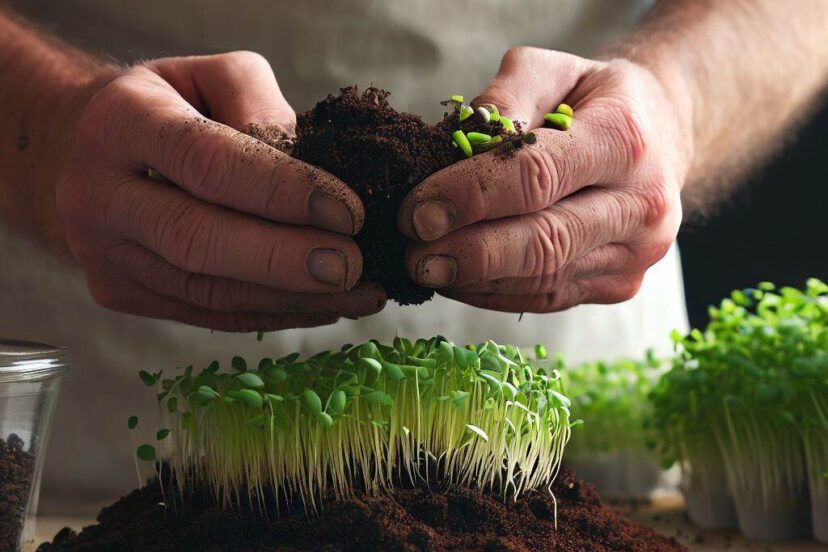Best Soil for Microgreens- The Essential Guide
Introduction
As a passionate microgreens enthusiast, I understand the importance of choosing the right soil for growing these delicate and nutritious plants. The soil you select plays a crucial role in providing the necessary nutrients, moisture retention, and drainage for healthy microgreens. In this article, I will guide you through the different factors to consider when selecting soil for microgreens and highlight some of the best soil options available.
What are Microgreens?
Microgreens are young, tender greens that are harvested just after the sprouting stage, typically when the first true leaves appear. They are packed with nutrients and flavors and have gained popularity in recent years due to their vibrant colors and culinary versatility. Growing microgreens at home allows you to have a constant supply of fresh greens that are perfect for garnishing salads, sandwiches, and various other dishes.
Importance of Choosing the Right Soil
Choosing the right soil for microgreens is crucial for their successful growth and development. Since microgreens have a short growing period, they rely heavily on the nutrients and conditions provided by the soil. The right soil will provide the necessary support, aeration, and nutrients required for their rapid growth. Moreover, it helps prevent common issues such as nutrient deficiencies, root rot, and stunted growth.
Factors to Consider when Selecting Soil for Microgreens
Nutrient Content
Microgreens require a nutrient-rich growing medium to thrive. Look for soils that contain a balanced mix of macronutrients (nitrogen, phosphorus, and potassium) as well as micronutrients (iron, magnesium, and calcium). A soil with a good nutrient profile ensures that your microgreens receive the necessary elements for healthy growth and vibrant coloration.
- Moisture Retention
The soil you choose should have good moisture retention properties. Microgreens have delicate root systems that require consistent moisture levels to grow properly. Soils that retain moisture well will prevent your microgreens from drying out and allow them to absorb water as needed. This helps in maintaining their turgidity and overall health.
- Drainage
While moisture retention is essential, it is equally important to have proper drainage to prevent waterlogging. Excess water can lead to root rot and other fungal diseases that can harm your microgreens. Look for soil mixes that strike a balance between moisture retention and adequate drainage to ensure healthy root development.
- pH Level
Microgreens thrive in a slightly acidic to neutral pH range. Aim for a soil pH between 6.0 and 7.0 for optimal growth. Testing the pH of your chosen soil or using a pH-adjusted soil mix will help maintain the right acidity levels, promoting nutrient uptake and minimizing nutrient deficiencies.
- Sterility
Using sterile soil is crucial to prevent the growth of pathogens and harmful bacteria that can hinder microgreen growth. Sterility ensures a clean and healthy growing environment for your microgreens. Look for sterilized soil or consider sterilizing the soil yourself before planting to minimize the risk of contamination.
Types of Soil Suitable for Microgreens
- Peat Moss
Peat moss is a popular choice for microgreen cultivation due to its excellent water retention capabilities. It provides a stable growing medium and retains moisture for an extended period, allowing the roots to absorb water as needed. Peat moss is also lightweight and has a neutral pH, making it a versatile option for various microgreen varieties.
- Coconut Coir
Coconut coir, derived from coconut husks, is an environmentally friendly alternative to peat moss. It has excellent water retention properties and provides a well-aerated growing medium. Coconut coir is also rich in nutrients and has a slightly acidic pH, which is beneficial for microgreen growth. It is an excellent choice for those seeking sustainable soil options.
- Vermiculite
Vermiculite is a mineral-based soil amendment that improves water retention and aeration. It helps the soil retain moisture while allowing excess water to drain away, preventing waterlogging. Vermiculite is lightweight, sterile, and pH-neutral, making it suitable for growing microgreens.
- Perlite
Perlite is another mineral-based soil amendment known for its excellent drainage properties. It improves aeration in the soil, preventing compaction and providing oxygen to the roots. Perlite is lightweight, sterile, and pH-neutral, making it a suitable choice for microgreens that require good airflow and drainage.
- Compost
Using compost as a soil amendment can provide a nutrient-rich growing medium for microgreens. Compost improves soil structure, enhances moisture retention, and supplies organic matter to support healthy plant growth. It is important to ensure that the compost is fully decomposed to avoid nutrient imbalances or the presence of weed seeds.
- Organic Potting Mix
An organic potting mix formulated specifically for seed starting and microgreen cultivation can be an excellent option. These mixes often contain a blend of peat moss, coconut coir, compost, and other organic materials. They are designed to provide a balanced nutrient profile, good moisture retention, and adequate drainage for optimal microgreen growth.
Tips for Using Soil for Microgreens
- Use Sterile Soil
To minimize the risk of disease and contamination, it is crucial to use sterile soil for microgreens. Sterilization can be achieved by baking the soil in an oven at a specific temperature or by purchasing pre-sterilized soil mixes.
- Mix in Organic Matter
Adding organic matter such as compost or well-rotted manure to your soil mix can improve its nutrient content and overall quality. Organic matter enhances soil structure, moisture retention, and nutrient availability, promoting healthy microgreen growth.
- Consider Soil Amendments
Soil amendments like vermiculite, perlite, or coconut coir can enhance the moisture retention and drainage properties of your soil mix. Mixing in these amendments helps create a well-balanced growing medium for microgreens.
- Water Properly
Proper watering is crucial for the success of your microgreens. Water your microgreens gently and evenly, keeping the soil consistently moist but not waterlogged. Overwatering can lead to root rot, while underwatering can cause stunted growth.
Conclusion
Selecting the best soil for microgreens is essential for their successful growth and nutritional value. Considering factors such as nutrient content, moisture retention, drainage, pH level, and sterility can help you choose the ideal soil type. Options like peat moss, coconut coir, vermiculite, perlite, compost, and organic potting mixes provide suitable growing mediums. By following the tips mentioned and paying attention to your microgreens’ specific needs, you can create an optimal environment for their growth and harvest flavorful and nutritious microgreens.
FAQs (Frequently Asked Questions)
- Can I reuse the soil for multiple microgreen batches?
- It is generally recommended to use fresh soil for each microgreen batch to prevent the buildup of pathogens and ensure optimal growth. However, you can compost used soil or sterilize it before reusing it.
- Is it necessary to adjust the pH of the soil for microgreens?
- Microgreens prefer a slightly acidic to neutral pH range. If your soil pH is outside this range, it is beneficial to adjust it using organic amendments or pH-adjusting products.
- Can I use garden soil for growing microgreens?
- Garden soil may not be suitable for microgreens due to its heavy texture and potential contamination with pests or diseases. It is best to use a sterile and well-balanced soil mix specifically formulated for microgreen cultivation.
- How often should I water my microgreens?
- Microgreens require consistent moisture levels. Water them gently and regularly, keeping the soil moist but not saturated. The frequency of watering will depend on environmental conditions and the moisture retention capacity of your soil mix.
- Can I use synthetic fertilizers for microgreens?
- While synthetic fertilizers can provide nutrients, it is recommended to use organic options for microgreens. Organic fertilizers release nutrients slowly and promote long-term soil health without the risk of chemical buildup.
Remember, choosing the right soil for microgreens is just the first step. Pay attention to other factors such as adequate lighting, proper ventilation, and suitable temperatures to ensure optimal growth. With the right soil and care, you can enjoy a continuous supply of delicious and nutrient-packed microgreens right at your fingertips. Happy growing!




